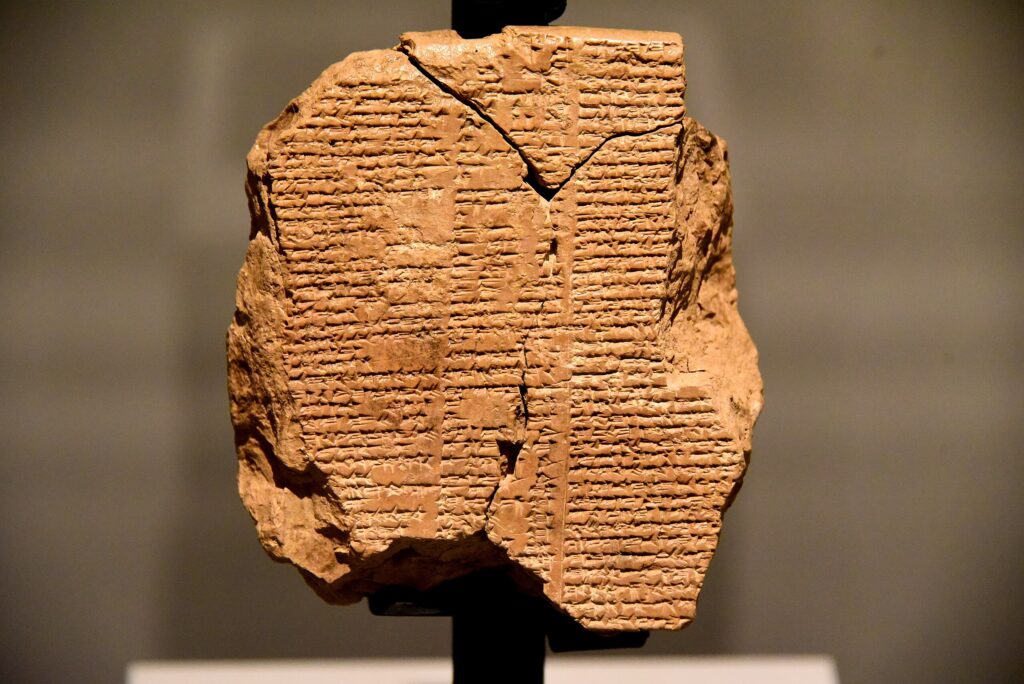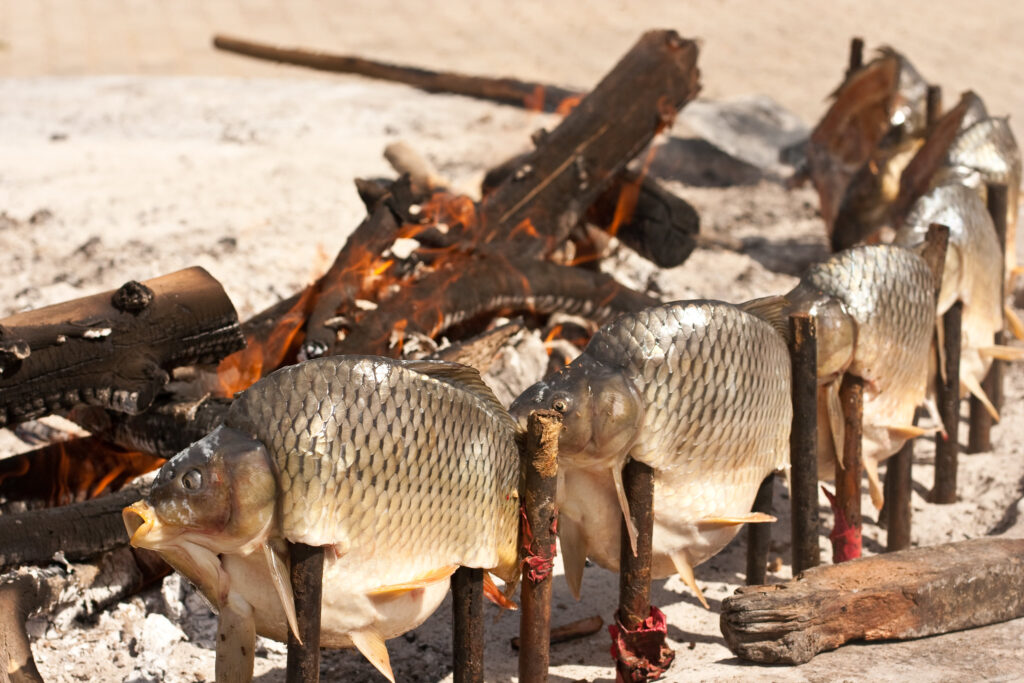Quick facts about Iraq:
- Population: Approximately 41 million people.
- Capital: Baghdad.
- Official Languages: Arabic and Kurdish.
- Other Languages: Assyrian Neo-Aramaic, Turkmen, and others are spoken by minority communities.
- Currency: Iraqi Dinar (IQD).
- Government: Federal parliamentary republic.
- Major Religion: Islam, predominantly Shia and Sunni.
- Geography: Located in the Middle East, bordered by Turkey to the north, Iran to the east, Kuwait to the southeast, Saudi Arabia to the south, Jordan to the southwest, and Syria to the west.
Fact 1: Iraq is an area of ancient civilizations
Iraq is a cradle of ancient civilizations, home to some of the earliest and most influential cultures in human history. Known historically as Mesopotamia, which means “the land between rivers” (referring to the Tigris and Euphrates), this region saw the rise of numerous powerful civilizations that laid the foundations for many aspects of modern society.
- Sumerians: The Sumerians are credited with creating one of the world’s first urban civilizations around 4500 BCE. They developed cuneiform writing, one of the earliest known writing systems, which they used for record-keeping, literature, and administrative purposes. The Sumerians also made significant advancements in mathematics, astronomy, and architecture, with their ziggurats serving as impressive examples of their engineering prowess.
- Akkadians: Following the Sumerians, the Akkadian Empire emerged under the leadership of Sargon of Akkad around 2334 BCE. This was one of the first empires in history, characterized by a centralized government and a standing army. The Akkadians continued the Sumerian tradition of writing and made their own contributions to Mesopotamian culture.
- Babylonians: The Babylonian civilization, particularly under King Hammurabi (circa 1792-1750 BCE), is renowned for the Code of Hammurabi, one of the earliest and most complete written legal codes. Babylon itself became a major cultural and economic center, with its Hanging Gardens later being counted among the Seven Wonders of the Ancient World.
- Assyrians: The Assyrian Empire, known for its military prowess and administrative efficiency, controlled a vast territory from the 25th century BCE to the 7th century BCE. The Assyrians built extensive road systems and developed a postal service, contributing to the cohesion and stability of their empire. The capital cities of Ashur and Nineveh were significant centers of power and culture.
- Other Civilizations: Iraq also encompasses the sites of other ancient civilizations such as the Chaldeans, who revitalized Babylon in the 7th and 6th centuries BCE, and the Parthians and Sassanids, who later ruled the region and contributed to its rich tapestry of history.

Fact 2: Iraq is currently not safe to visit
Iraq is currently considered unsafe for tourists due to ongoing security concerns, including the presence of ISIS (Islamic State of Iraq and Syria). Despite efforts by the Iraqi government and international forces to combat and diminish ISIS’s influence, the group has continued to carry out attacks and maintain pockets of control in certain areas. This instability, coupled with other security challenges, makes travel to Iraq risky for foreigners. Governments around the world typically advise their citizens to avoid non-essential travel to Iraq due to these dangers.
Nevertheless, Iraq is still visited for various reasons, to comply with the rules for part of the foreigners need an International Driver’s License in Iraq, as well as health insurance. Check with the Ministry of Foreign Affairs for guidelines and rules for visiting the country.
Fact 3: Writing originated in Iraq
The earliest known form of writing, cuneiform, was developed by the Sumerians of ancient Mesopotamia around 3200 BCE. This writing system emerged as a means to keep records and manage the complexities of an increasingly urban and bureaucratic society.
Cuneiform started as a series of pictographs, representing objects and ideas, which were inscribed on clay tablets using a reed stylus. Over time, these pictographs evolved into more abstract symbols, representing sounds and syllables, allowing for the recording of a broader range of information, including legal codes, literature, and administrative documents.
One of the most famous pieces of literature from this period is the “Epic of Gilgamesh” a poetic work that explores themes of heroism, friendship, and the quest for immortality.

Fact 4: Iraq is very rich in oil
It possesses the fifth-largest proven oil reserves globally, estimated at around 145 billion barrels. This abundant natural resource has been a cornerstone of Iraq’s economy, contributing significantly to its GDP and government revenues.
The country’s major oil fields are located primarily in the south, near Basra, and in the north, near Kirkuk. The Basra region, in particular, is home to some of the largest and most productive oil fields, including the Rumaila, West Qurna, and Majnoon fields. These fields have attracted substantial investments from international oil companies, helping to boost production capacities.
Oil production in Iraq has a long history, with the first commercial oil well drilled in 1927. Since then, the industry has seen periods of expansion and contraction due to political instability, wars, and international sanctions.
Fact 5: Ruins of ancient cities have been preserved in Iraq
Iraq is home to numerous well-preserved ruins of ancient cities, reflecting its rich history as a cradle of civilization. These archaeological sites provide invaluable insights into the early development of urban life, culture, and governance.
- Babylon: Perhaps the most famous of these ancient cities is Babylon, located near modern-day Baghdad. Once the capital of the Babylonian Empire, it reached its zenith under King Nebuchadnezzar II in the 6th century BCE. Babylon is renowned for its impressive structures such as the Ishtar Gate, with its striking blue-glazed bricks and depictions of dragons and bulls. The city is also legendary for the Hanging Gardens, one of the Seven Wonders of the Ancient World, though their existence remains debated among historians.
- Ur: Ur, another significant site, lies in southern Iraq near Nasiriyah. This Sumerian city, dating back to around 3800 BCE, is famed for its well-preserved ziggurat, a massive terraced structure dedicated to the moon god Nanna. Ur was a major center of trade, culture, and religion and is believed to be the birthplace of the biblical patriarch Abraham.
- Nineveh: The ancient city of Nineveh, near modern-day Mosul, was once the capital of the powerful Assyrian Empire. Dating back to around 700 BCE, Nineveh was renowned for its impressive walls, palaces, and the extensive library of Ashurbanipal, which housed thousands of clay tablets in cuneiform script. The city’s ruins include the remains of the grand palace of Sennacherib and the Temple of Ishtar.
- Nimrud: Nimrud, also an important Assyrian city, is located south of Mosul. Founded in the 13th century BCE, it flourished under King Ashurnasirpal II, who built a magnificent palace adorned with elaborate reliefs and colossal statues of winged bulls, known as lamassu. The city’s archaeological significance is immense, though it has suffered damage from conflict in recent years.
- Hatra: Hatra, situated in the Al-Jazira region, is a Parthian city that flourished between the 1st and 2nd centuries CE. Known for its well-preserved temples and defensive walls, Hatra was a major religious and trading center. Its impressive architecture and the fusion of Greek, Roman, and Eastern influences make it a UNESCO World Heritage site.

Fact 6: Iraq is a country of diverse landscapes
Contrary to popular perception, Iraq is a country of diverse landscapes. Beyond its well-known desert regions, Iraq boasts fertile plains, mountainous areas, and lush marshlands.
In the north, the rugged Zagros Mountains provide a stark contrast to the flat plains, offering dense forests and picturesque valleys. This region is cooler and receives more rainfall, supporting a different array of flora and fauna. Additionally, southern Iraq is home to the Mesopotamian Marshes, one of the most unique wetlands in the world, characterized by vast reed beds and waterways that sustain diverse wildlife and the traditional Marsh Arab culture.
While deserts do cover significant portions of Iraq, particularly in the west and south, these arid landscapes also have their own variety, with rocky outcrops, plateaus, and sand dunes. The river valleys of the Tigris and Euphrates are vital lifelines, providing essential water resources that support agriculture, drinking, and industry, shaping both historical and contemporary settlement patterns. This geographical diversity makes Iraq a country of rich and varied environments, far beyond its desert image.
Fact 7: Iraqi cuisine is very varied and delicious
Iraqi cuisine is varied and delicious, reflecting the country’s rich history and diverse cultural influences. It combines flavors and techniques from the ancient Mesopotamian civilization, as well as Persian, Turkish, and Levantine traditions, resulting in a unique and flavorful culinary tradition.
One of the staples of Iraqi cuisine is rice, often served with stews (known as “tashreeb”) and meats. Biryani, a spiced rice dish mixed with meats and vegetables, is particularly popular. Kebabs and grilled meats such as lamb and chicken, often marinated in a blend of spices, are common features at meals, showcasing the region’s love for hearty, flavorful dishes.
Another beloved dish is masgouf, a traditional method of grilling fish, particularly carp, which is marinated with olive oil, salt, and turmeric before being grilled over an open flame. This dish is often enjoyed by the banks of the Tigris River, where fresh fish is abundant.
Vegetables and legumes play a significant role in Iraqi cuisine, with dishes like dolma (stuffed grape leaves and vegetables) and fasolia (a bean stew) being everyday staples. Bread, especially flatbreads like khubz and samoon, is an essential accompaniment to most meals.
For those with a sweet tooth, Iraqi desserts are a delight. Baklava, halva, and knafeh are popular, featuring rich flavors of honey, nuts, and fragrant spices. Date-based sweets are also common, reflecting Iraq’s status as one of the world’s largest producers of dates.
In addition to these traditional dishes, Iraqi cuisine is also characterized by its use of a wide range of spices, such as cumin, coriander, cardamom, and saffron, which add depth and complexity to the food.

Fact 8: Muslims believe that Noah’s Ark was built in Iraq
Muslims believe that Noah’s Ark was constructed in what is now modern-day Iraq. According to Islamic tradition, Prophet Noah (Nuh in Arabic) was instructed by God to build the Ark in the land of Mesopotamia, which corresponds to parts of present-day Iraq.
The story of Noah is detailed in several chapters (Surahs) of the Quran, particularly in Surah Hud and Surah Nuh. It describes how Noah was commanded by God to warn his people of impending divine punishment due to their wickedness and idolatry. Despite Noah’s efforts, only a small group of believers heeded his warning. God then instructed Noah to build a large vessel to save his followers, along with pairs of animals, from the forthcoming deluge.
The construction site of the Ark is often associated with the ancient Mesopotamian region, a cradle of early civilizations. This area, rich in historical and religious significance, is believed by many to be the setting for numerous biblical and Quranic events. The specific location of the Ark’s construction is not detailed in the Quran, but Islamic scholars and historians traditionally place it in this region due to its historical and geographical context.
Fact 9: Nadia Murad is the only Nobel laureate from Iraq
Nadia Murad, a Yazidi human rights activist, is indeed the only Nobel laureate from Iraq. She was awarded the Nobel Peace Prize in 2018 for her efforts to end the use of sexual violence as a weapon of war and armed conflict. Nadia Murad’s advocacy focuses on the plight of Yazidi women and girls who were abducted and enslaved by ISIS (Islamic State of Iraq and Syria) militants in northern Iraq in 2014.
Born in the village of Kocho near Sinjar, Iraq, Nadia Murad was herself abducted by ISIS and endured months of captivity and abuse before escaping. Since then, she has become a prominent voice for victims of human trafficking and sexual violence in conflict zones.

Fact 10: The city of Samarra in Iraq has two of the largest mosques in the world
The city of Samarra in Iraq is renowned for its architectural and historical significance, notably housing two of the largest mosques in the Islamic world: the Great Mosque of Samarra (Masjid al-Mutawakkil) and the Malwiya Minaret.
Great Mosque of Samarra (Masjid al-Mutawakkil)
Built in the 9th century during the Abbasid Caliphate under the reign of Caliph al-Mutawakkil, the Great Mosque of Samarra is an impressive example of early Islamic architecture. Its most distinctive feature is the spiral minaret, which originally stood at an astounding height of around 52 meters (171 feet), making it one of the tallest minarets ever constructed. Although damaged over the centuries, the mosque remains a significant historical and architectural landmark, reflecting the grandeur and innovation of Abbasid-era Islamic architecture.
Malwiya Minaret
Adjacent to the Great Mosque is the Malwiya Minaret, also known as the Al-Malwiya Tower. This unique minaret is characterized by its spiral, cylindrical structure, similar to a snail shell, and is approximately 52 meters (171 feet) in height. The minaret served both a functional and symbolic purpose, used for the call to prayer (adhan) and also as a visual symbol of the Abbasid Caliphate’s power and influence.
Both structures, the Great Mosque and the Malwiya Minaret, are part of the archaeological site of Samarra, recognized as a UNESCO World Heritage site since 2007. They stand as testament to the architectural and cultural achievements of the Abbasid period in Iraq, showcasing the city’s historical importance as a center of Islamic civilization during the medieval era.

Published July 07, 2024 • 11m to read





